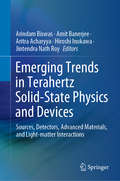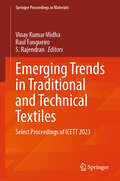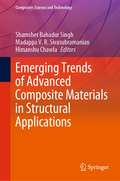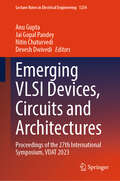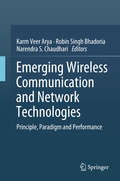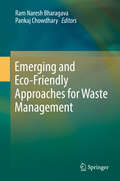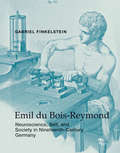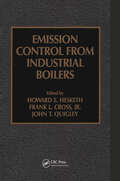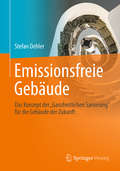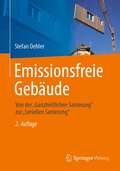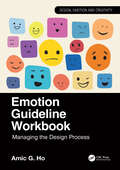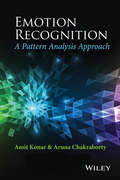- Table View
- List View
Emerging Trends in Terahertz Engineering and System Technologies: Devices, Materials, Imaging, Data Acquisition and Processing
by Amit Banerjee Arindam Biswas Aritra Acharyya Hiroshi InokawaThis book highlights emerging trends in terahertz engineering and system technologies, mainly, devices, advanced materials, and various applications in THz technology. It includes advanced topics such as terahertz biomedical imaging, pattern recognition and tomographic reconstruction for THz biomedical imaging by use of machine learning and artificial intelligence, THz imaging radars for autonomous vehicle applications, THZ imaging system for security and surveillance. It also discusses theoretical, experimental, established and validated empirical work on these topics and the intended audience is both academic and professional.
Emerging Trends in Terahertz Solid-State Physics and Devices: Sources, Detectors, Advanced Materials, and Light-matter Interactions
by Amit Banerjee Arindam Biswas Aritra Acharyya Hiroshi Inokawa Jintendra Nath RoyThis book highlights recent advances and applications in terahertz (THz) technology, addressing advanced topics such as THz biomedical imaging, pattern recognition and tomographic reconstruction for THz biomedical imaging by machine learning and artificial intelligence, THz imaging radars for autonomous vehicle applications, and THz imaging systems for security and surveillance. It also discusses theoretical, experimental, established and validated empirical work on these topics.
Emerging Trends in Traditional and Technical Textiles: Select Proceedings of ICETT 2023 (Springer Proceedings in Materials #55)
by Raul Fangueiro S. Rajendran Vinay Kumar MidhaThis book presents the select proceedings of the 3rd International Conference on Emerging Trends in Traditional and Technical Textiles (ICETT 2023) and examines the latest developments and applications in the field of textile materials, with a special focus on technical textiles. The topics covered include geotextiles, medical and healthcare textiles, protective textiles, thermal behavior of textiles, functional finishing of textiles, composites and green textiles. The book also discusses the dyeing, printing and fastness properties of the textile materials. This book is a valuable reference for researchers and professionals working in traditional textile design and technical textile applications.
Emerging Trends in the Evolution of Service-Oriented and Enterprise Architectures
by Lakhmi C. Jain Eman El-Sheikh Alfred ZimmermannThis book presents emerging trends in the evolution of service-oriented and enterprise architectures. New architectures and methods of both business and IT are integrating services to support mobility systems, Internet of Things, Ubiquitous Computing, collaborative and adaptive business processes, Big Data, and Cloud ecosystems. They inspire current and future digital strategies and create new opportunities for the digital transformation of next digital products and services. Services Oriented Architectures (SOA) and Enterprise Architectures (EA) have emerged as a useful framework for developing interoperable, large-scale systems, typically implementing various standards, like Web Services, REST, and Microservices. Managing the adaptation and evolution of such systems presents a great challenge. Service-Oriented Architecture enables flexibility through loose coupling, both between the services themselves and between the IT organizations that manage them. Enterprises evolve continuously by transforming and extending their services, processes and information systems. Enterprise Architectures provide a holistic blueprint to help define the structure and operation of an organization with the goal of determining how an organization can most effectively achieve its objectives. The book proposes several approaches to address the challenges of the service-oriented evolution of digital enterprise and software architectures.
Emerging Trends of Advanced Composite Materials in Structural Applications (Composites Science and Technology)
by Shamsher Bahadur Singh Madappa V. R. Sivasubramanian Himanshu ChawlaThis book introduces different advanced composite materials used in construction of civil engineering infrastructures. It reflects the latest manufacturing processes and applications in the civil structures. This book also includes test cases and its validation with finite element method using computer software. Moreover, the book also deals with design methodology of advanced composite materials based on different applications. The comprehensive overview of the state-of-the-art research on the composite materials presented herein is of interest to scientists, researchers, students and engineers, and practitioners in general working in area of innovative composite materials and structures. This book is also helpful for Ph.D. research scholars for developing their fundamental understanding on advanced materials, and it is also appropriate for master and undergraduate level courses on composite materials.
Emerging Two Dimensional Materials and Applications (Emerging Materials and Technologies)
by Arun Kumar Singh Ram Sevak Singh Anar SinghThis book details 2D nanomaterials, and their important applications—including recent developments and related scalable technologies crucial to addressing strong societal demands of energy, environmental protection, and worldwide health concerns—are systematically documented. It covers syntheses and structures of various 2D materials, electrical transport in graphene, and different properties in detail. Applications in important areas of energy harvesting, energy storage, environmental monitoring, and biosensing and health care are elaborated. Features: Facilitates good understanding of concepts of emerging 2D materials and its applications. Covers details of highly sensitive sensors using 2D materials for environmental monitoring. Outlines the role of 2D materials in improvement of energy harvesting and storage. Details application in biosensing and health care for the realization of next-generation biotechnologies for personalized health monitoring and so forth. Provides exclusive coverage of inorganic 2D MXenes compounds. This book is aimed at graduate students and researchers in materials science and engineering, nanoscience and nanotechnology, and electrical engineering.
Emerging VLSI Devices, Circuits and Architectures: Proceedings of the 27th International Symposium, VDAT 2023 (Lecture Notes in Electrical Engineering #1234)
by Anu Gupta Jai Gopal Pandey Nitin Chaturvedi Devesh DwivediThis book constitutes the proceedings of the 27th International Symposium on VLSI Design and Test, VDAT 2023. The 32 regular papers and 16 short papers presented in this book are carefully reviewed and selected from 220 submissions. They are organized in topical sections as follows: Low-Power Integrated Circuits and Devices; FPGA-Based Design and Embedded Systems; Memory, Computing, and Processor Design; CAD for VLSI; Emerging Integrated Circuits and Systems; VLSI Testing and Security; and System-Level Design.
Emerging Wireless Communication and Network Technologies: Principle, Paradigm and Performance
by Robin Singh Bhadoria Karm Veer Arya Narendra S. ChaudhariThe book covers a wide range of wireless communication and network technologies, and will help readers understand the role of wireless technologies in applications touching on various spheres of human life, e.g. healthcare, agriculture, building smart cities, forecasting and the manufacturing industry.The book begins by discussing advances in wireless communication, including emerging trends and research directions for network technologies. It also highlights the importance of and need to actively develop these technologies. In turn, the book addresses different algorithms and methodologies which could be beneficial in implementing 5G Mobile Communication, Vehicular Ad-hoc Networks (VANET), Reliable Cooperative Networks, Delay Tolerant Networks (DTN) and many more contexts related to advanced communications. It then addresses the prominence of wireless communication in connection with the Internet of Things (IoT), Mobile Opportunistic Networks and Cognitive Radio Networks (CRN). Lastly, it presents the new horizons in architecture and building protocols for Li-Fi (Light-Fidelity) and Wearable Sensor Technology.
Emerging Wireless Networks: Concepts, Techniques and Applications
by Samuel Pierre Christian MakayaAn authoritative collection of research papers and surveys, Emerging Wireless Networks: Concepts, Techniques, and Applications explores recent developments in next-generation wireless networks (NGWNs) and mobile broadband networks technologies, including 4G (LTE, WiMAX), 3G (UMTS, HSPA), WiFi, mobile ad hoc networks, mesh networks, and wireles
Emerging Workforce Trends in the U.S. Energy and Mining Industries: A Call to Action
by Committee on Earth ResourcesEnergy and mineral resources are essential for the nation's fundamental functions, its economy, and security. Nonfuel minerals are essential for the existence and operations of products that are used by people every day and are provided by various sectors of the mining industry. Energy in the United States is provided from a variety of resources including fossil fuels, and renewable and nuclear energy, all with established commercial industry bases. The United States is the largest electric power producer in the world. The overall value added to the U. S. gross domestic product (GDP) in 2011 by major industries that consumed processed nonfuel mineral materials was $2. 2 trillion. Recognizing the importance of understanding the state of the energy and mining workforce in the United States to assure a trained and skilled workforce of sufficient size for the future, the Department of Energy's (DOE's) National Energy technology Laboratory (NETL) contracted with the National Research Council (NRC) to perform a study of the emerging workforce trends in the U. S. energy and mining industries. Emerging Workforce Trends in the U. S. Energy and Mining Industries: A Call to Action summarizes the findings of this study.
Emerging and Eco-Friendly Approaches for Waste Management
by Ram Naresh Bharagava Pankaj ChowdharyRapid industrialization is a serious concern in the context of a healthy environment. With the growth in the number of industries, the waste generated is also growing exponentially. The various chemical processes operating in the manufacturing industry generate a large number of by-products, which are largely harmful and toxic pollutants and are generally discharged into the natural water bodies. Once the pollutants enter the environment, they are taken up by different life forms, and because of bio-magnification, they affect the entire food chain and have severe adverse effects on all life forms, including on human health. Although, various physico-chemical and biological approaches are available for the removal of toxic pollutants, unfortunately these are often ineffective and traditional clean up practices are inefficient. Biological approaches utilizing microorganisms (bacterial/fungi/algae), green plants or their enzymes to degrade or detoxify environmental pollutants such as endocrine disruptors, toxic metals, pesticides, dyes, petroleum hydrocarbons and phenolic compounds, offer eco- friendly approaches. Such eco-friendly approaches are often more effective than traditional practices, and are safe for both industry workers as well as environment. This book provides a comprehensive overview of various toxic environmental pollutants from a variety natural and anthropogenic sources, their toxicological effects on the environment, humans, animals and plants as well as their biodegradation and bioremediation using emerging and eco-friendly approaches (e.g. Anammox technology, advanced oxidation processes, membrane bioreactors, membrane processes, GMOs), microbial degradation (e.g. bacteria, fungi, algae), phytoremediation, biotechnology and nanobiotechnology. Offering fundamental and advanced information on environmental problems, challenges and bioremediation approaches used for the remediation of contaminated sites, it is a valuable resource for students, scientists and researchers engaged in microbiology, biotechnology and environmental sciences.
Emerging and Innovative Arsenic Removal Technologies for a Sustainable Future (Water Science and Technology Library #131)
by Akhilesh Kumar Yadav Saba ShirinThis book presents an overview of the techniques available today to remove arsenic contamination, pollutants, and species from water. Traditionally applied techniques for removal of arsenic pollutants/species, including oxidation, coagulation-flocculation, and membrane techniques. Furthermore, recent progress has been made on the utility of various nanoparticles for the extraction of contaminated water. Arsenic contamination affects the quality of water resources worldwide as a result of human activities (pesticides and other uses). Due to the insufficiency of water treatment facilities in developing countries, oral exposure to chemical toxicants through drinking water is a health threat. Arsenic is a mobile element with a crustal abundance of 1.8 mg kg-1 and can travel in different components of the environment, including air, soil, and water before entering into its ultimate sink, that is, bottom sediments and sea. Arsenic may enter groundwater from both geogenic and anthropogenic sources and primarily exists in inorganic form as oxy-anions. Groundwater is relatively more vulnerable to arsenic contamination from geothermal inputs, including the weathering and dissolution of arsenic-bearing rocks and minerals. Arsenic mobility is enhanced in subsurface anoxic conditions, making groundwater more vulnerable to arsenic contamination. Ingestion of groundwater-laden arsenic may cause carcinogenic and non-carcinogenic health ailments. Chronic oral exposure ≤ 50 µg L-1 of arsenic can cause skin lesions, skin cancer, melanosis, hyperkeratosis, hypertension, gangrene, cardiovascular problems, black foot disease, neuropathy, peripheral vascular disease, restrictive lung disease, bladder cancer, lung cancer etc. Hence, specific water treatment processes are required to meet anticipated more severe water quality standards. A better understanding of currently available processes is necessary to develop economical, efficient and effective methods for arsenic removal. Arsenic can be coated, adsorbed using a wide range of mineral and organic or can be directly rejected by membrane processes such as reverse osmosis and nanofiltration. The recent development of submerged hybrid membrane systems, such as membrane bioreactors in wastewater treatment, provides alternative technologies for arsenic treatment.
Emerging and Priority Pollutants in Rivers
by Helena Guasch Antoni Ginebreda Anita GeiszingerThe enduring changes in the aquatic environment and the increasing influx of contaminants call for novel conceptual and methodological approaches to relating chemical pollution and ecological alterations in ecosystems. This volume highlights the latest advances concerning the sampling, analyses, occurrence, bioavailability, and effects of emerging and priority pollutants in European rivers, the current status of the River Management Plans in Europe, and the applicability of the newly developed techniques for water monitoring purposes. The topics are discussed in the context of the EU Water Framework Directive, evaluating their shortcomings and providing a basis for doing away with them. Linking scientific research and river management practices, this book is an invaluable source of information for environmental chemists, aquatic scientists, ecologists and water managers.
Emil du Bois-Reymond: Neuroscience, Self, and Society in Nineteenth-Century Germany (Transformations: Studies in the History of Science and Technology)
by Gabriel FinkelsteinA biography of an important but largely forgotten nineteenth-century scientist whose work helped lay the foundation of modern neuroscience.Emil du Bois-Reymond is the most important forgotten intellectual of the nineteenth century. In his own time (1818–1896) du Bois-Reymond grew famous in his native Germany and beyond for his groundbreaking research in neuroscience and his provocative addresses on politics and culture. This biography by Gabriel Finkelstein draws on personal papers, published writings, and contemporary responses to tell the story of a major scientific figure. Du Bois-Reymond's discovery of the electrical transmission of nerve signals, his innovations in laboratory instrumentation, and his reductionist methodology all helped lay the foundations of modern neuroscience.In addition to describing the pioneering experiments that earned du Bois-Reymond a seat in the Prussian Academy of Sciences and a professorship at the University of Berlin, Finkelstein recounts du Bois-Reymond's family origins, private life, public service, and lasting influence. Du Bois-Reymond's public lectures made him a celebrity. In talks that touched on science, philosophy, history, and literature, he introduced Darwin to German students (triggering two days of debate in the Prussian parliament); asked, on the eve of the Franco-Prussian War, whether France had forfeited its right to exist; and proclaimed the mystery of consciousness, heralding the age of doubt. The first modern biography of du Bois-Reymond in any language, this book recovers an important chapter in the history of science, the history of ideas, and the history of Germany.
Emily Eternal
by M. G. WheatonMeet Emily, "the best AI character since HAL 9000" (Blake Crouch). She can solve advanced mathematical problems, unlock the mind's deepest secrets, but unfortunately, even she can't restart the sun. <P><P> Emily is an artificial consciousness, designed in a lab to help humans process trauma, which is particularly helpful when the sun begins to die 5 billion years before scientists agreed it was supposed to. <P><P>Her beloved human race is screwed, and so is Emily. That is, until she finds a potential answer buried deep in the human genome that may save them all. <P><P>But not everyone is convinced Emily has the best solution--or the best intentions. Before her theory can be tested, the lab is brutally attacked, and Emily's servers are taken hostage. <P><P>Narrowly escaping, Emily is forced to go on the run with two human companions--college student Jason and small-town Sheriff, Mayra. As the sun's death draws near, Emily and her friends must race against time to save humanity. <P><P>Soon it becomes clear not just the species is at stake, but also that which makes us most human.
Emission Control from Industrial Boilers
by John T. Quigley Frank L. Cross Jr. Howard D. HeskethFrom the PrefaceThe Clean Air Act Amendments (CAAA) of 1990 significantly affect commercial and industrial combustion devices such as boilers, incinerators, and other burners. Under the new emission regulations already promulgated and those being developed, compliance will require improved equipment, more detailed operator training, new permits
Emissionsfreie Gebäude
by Stefan OehlerDieses Buch stellt das Konzept der „Ganzheitlichen Sanierung“ vor, auf der Suche nach dem kürzesten Weg hin zum emissionsfreien Gebäudebestand. Dabei wird vom Zielzustand 2050 aus gedacht und geplant. Durch diese langfristige Perspektive wird ein effektiveres Vorgehen ermöglicht, denn man vermeidet dadurch, sich mit halbherzigen Sanierungsschritten die Zukunft zu verbauen.Wie solche annähernd emissionsfreien Gebäude bereits heute realisiert werden, beschreibt die abgeschlossene Sanierung eines Sparkassengebäudes mit einer abgestimmten Kombination aus Energieeffizienz, Erneuerbaren Energien und Einbeziehung der Mitarbeiter. Die vielschichtigen Maßnahmen werden Schritt für Schritt diskutiert, um die in der Praxis gemachten Erfahrungen für alle, die sich mit Sanierungen beschäftigen werden, weiter zu geben. Die Mitarbeiter der Sparkasse sind über den Zugewinn an Komfort und Umweltfreundlichkeit begeistert und der Sanierungsfahrplan weist einen Weg zum emissionsfreien Gebäude der Zukunft.
Emissionsfreie Gebäude: Von der „Ganzheitlichen Sanierung“ zur „Seriellen Sanierung“
by Stefan OehlerDieses Buch stellt die Konzepte „Ganzheitlichen Sanierung“ und davon abgeleitet die „serielle Sanierung“ vor. Es beschreibt den direktesten Weg hin zum CO2-neutralen Gebäudebestand. Dabei wird vom Zielzustand 2045 aus gedacht und geplant. Durch diese langfristige Perspektive wird ein effektiveres Vorgehen ermöglicht, denn man vermeidet dadurch, sich mit halbherzigen Sanierungsschritten die Zukunft zu verbauen und unnötiges Geld auszugeben.Wie solche CO2-neutralen Gebäude bereits heute realisiert werden, beschreibt die abgeschlossene Sanierung eines Sparkassengebäudes mit einer abgestimmten Kombination aus Energieeffizienz, Erneuerbaren Energien und Einbeziehung der Mitarbeiter. Die vielschichtigen Maßnahmen werden Schritt für Schritt diskutiert, um die in der Praxis gemachten Erfahrungen für alle, die sich mit Sanierungen beschäftigen, weiter zu geben. Im letzten Kapitel werden die neuesten Entwicklungen der seriellen Sanierung beschrieben und ein Ausblick über sein vielversprechendes Potenzial gegeben.
Emma Darwin: The Wife of an Inspirational Genius
by Edna HealeyMuch has been written about Charles Darwin but this is the first biography of his strong, intelligent wife. Emma Wedgwood, granddaughter of the famous Josiah, married Charles Darwin in 1839, three years after he returned from his extraordinary voyage on the Beagle. Their life together was intellectually exciting though overshadowed by personal tragedy. Edna Healey has discovered new, and hitherto unpublished, material and has had the full support of the Darwin family in writing this major biography.
Emma Darwin: The Wife of an Inspirational Genius
by Edna HealeyMuch has been written about Charles Darwin but this is the first biography of his strong, intelligent wife. Emma Wedgwood, granddaughter of the famous Josiah, married Charles Darwin in 1839, three years after he returned from his extraordinary voyage on the Beagle. Their life together was intellectually exciting though overshadowed by personal tragedy. Edna Healey has discovered new, and hitherto unpublished, material and has had the full support of the Darwin family in writing this major biography.
Emotion Guideline Workbook: Managing the Design Process (Design, Emotion and Creativity)
by Amic G. HoManipulating the design process can be challenging for junior design, art and creative students. Besides understanding the approaches to managing the design factors with logical thinking, they can lack experience in handling emotional changes and concerns and initiative factors during the design process. As a result, they struggle to practice design and need guidance for enhancing their decision-making, evaluation, judgment, and motivation.This book proposes a set of guiding principles with the intention of assisting the reader in regulating the emotional changes that occur throughout the design process. This book offers practical approaches to those who would like to incorporate emotion in their design processes, which contrasts with previous scholarly research that has mostly focused on the theoretical level. It provides guidance to the reader through the process of adapting to the emotional changes that may occur throughout the design process during their design studies. It contains a literature review, research methods and a discussion of the strengths and limitations. Featuring printable worksheets and additional tables to use as guidance, this highly practical text allows the reader to gain a full understanding of emotion in the design procedure through active involvement process.The Emotion Guideline Workbook is perfect for design, art and creative students, as well as their instructors, researchers, and other learners who are interested in emotion-driven design. It will also appeal to students and academics in the fields of psychology and education.
Emotion Recognition
by Aruna Chakraborty Amit KonarOffers both foundations and advances on emotion recognition in a single volumeProvides a thorough and insightful introduction to the subject by utilizing computational tools of diverse domainsInspires young researchers to prepare themselves for their own researchDemonstrates direction of future research through new technologies, such as Microsoft Kinect, EEG systems etc.
Emotion Recognition and Understanding for Emotional Human-Robot Interaction Systems (Studies in Computational Intelligence #926)
by Witold Pedrycz Min Wu Luefeng Chen Kaoru HirotaThis book focuses on the key technologies and scientific problems involved in emotional robot systems, such as multimodal emotion recognition (i.e., facial expression/speech/gesture and their multimodal emotion recognition) and emotion intention understanding, and presents the design and application examples of emotional HRI systems. Aiming at the development needs of emotional robots and emotional human–robot interaction (HRI) systems, this book introduces basic concepts, system architecture, and system functions of affective computing and emotional robot systems. With the professionalism of this book, it serves as a useful reference for engineers in affective computing, and graduate students interested in emotion recognition and intention understanding. This book offers the latest approaches to this active research area. It provides readers with the state-of-the-art methods of multimodal emotion recognition, intention understanding, and application examples of emotional HRI systems.
Emotion Recognition using Speech Features
by K. Sreenivasa Rao Shashidhar G. Koolagudi"Emotion Recognition Using Speech Features" provides coverage of emotion-specific features present in speech. The author also discusses suitable models for capturing emotion-specific information for distinguishing different emotions. The content of this book is important for designing and developing natural and sophisticated speech systems. In this Brief, Drs. Rao and Koolagudi lead a discussion of how emotion-specific information is embedded in speech and how to acquire emotion-specific knowledge using appropriate statistical models. Additionally, the authors provide information about exploiting multiple evidences derived from various features and models. The acquired emotion-specific knowledge is useful for synthesizing emotions. Features includes discussion of: * Global and local prosodic features at syllable, word and phrase levels, helpful for capturing emotion-discriminative information; * Exploiting complementary evidences obtained from excitation sources, vocal tract systems and prosodic features in order to enhance the emotion recognition performance; * Proposed multi-stage and hybrid models for improving the emotion recognition performance. This brief is for researchers working in areas related to speech-based products such as mobile phone manufacturing companies, automobile companies, and entertainment products as well as researchers involved in basic and applied speech processing research.
Emotion and Performance: A Special Issue of Human Performance
by Neal M. AshkanasyIn this special issue, five papers address the study of emotions from a variety of viewpoints. Two are theoretical essays that deal respectively with emotion and creativity and the relationships between individual and team performance. Three are empirical studies that canvas the emotion-performance nexus across levels of analysis: within-person, between-person, and in groups. Between them, the five papers present a strong case for the nexus of emotions and performance, but more importantly provide a platform for potentially fruitful future research in this burgeoning area.

